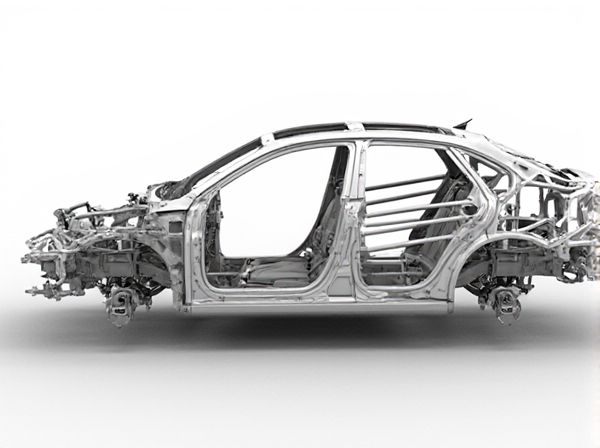
Photo illustration: Ladder Frame vs Unibody Frame
A ladder frame offers superior durability and ease of repair, making it ideal for heavy-duty trucks and off-road vehicles, while a unibody frame provides better fuel efficiency and improved handling through its integrated design. Your choice depends on whether you prioritize ruggedness and towing capacity or a lighter, more responsive ride. Understanding these differences helps you select the best vehicle frame for your specific driving needs.
Table of Comparison
| Feature | Ladder Frame | Unibody Frame |
|---|---|---|
| Structure | Two parallel steel beams connected by cross members | Integrated body and frame forming a single unit |
| Weight | Heavier, increases vehicle weight | Lighter, improves fuel efficiency |
| Strength | High durability, suited for heavy loads and off-road | Optimized for crash safety and rigidity |
| Ride Comfort | Less refined, stiffer ride | Smoother ride due to integrated design |
| Cost | Lower manufacturing cost | Higher production cost due to complexity |
| Common Use | Trucks, SUVs, heavy-duty vehicles | Passenger cars, crossovers, some SUVs |
Introduction to Automotive Frame Structures
Ladder frame and unibody frame represent two fundamental types of automotive frame structures, each impacting vehicle strength and weight differently. Ladder frames consist of two strong, parallel beams connected by crossmembers, providing excellent durability and off-road capability, commonly used in trucks and SUVs. Unibody frames integrate the body and frame into a single structure, reducing overall weight and improving fuel efficiency, which is preferred in most modern passenger cars.
What is a Ladder Frame?
A ladder frame is a type of vehicle chassis construction characterized by two longitudinal metal beams connected by several lateral cross members, forming a shape similar to a ladder. This design provides high durability and strength, making it ideal for heavy-duty trucks and off-road vehicles. Ladder frames offer superior load-bearing capacity and easier repairability compared to unibody frames, but typically result in a heavier overall vehicle weight.
What is a Unibody Frame?
A unibody frame integrates the vehicle's body and chassis into a single cohesive structure, enhancing rigidity and reducing overall weight compared to the traditional ladder frame. This design improves crash safety, handling, and fuel efficiency by distributing impact forces more evenly across the body. Unibody construction is commonly used in passenger cars and crossover SUVs due to its balance of strength and performance benefits.
Historical Evolution of Vehicle Frames
Early vehicles predominantly used ladder frames, characterized by two parallel beams connected by cross members, providing durability and ease of repair for heavy-duty applications. The unibody frame emerged in the mid-20th century, integrating the body and chassis into a single structure, enhancing vehicle rigidity, safety, and weight reduction. Advancements in materials and manufacturing techniques have driven the transition from ladder to unibody designs, influencing modern automotive engineering trends.
Strengths of Ladder Frame Construction
Ladder frame construction provides superior durability and strength, especially for heavy-duty vehicles and off-road conditions, due to its robust, separate chassis design that can withstand significant torsional stress. This frame type allows easier repairs and modifications, enhancing maintenance efficiency and customization capabilities. Its high load-bearing capacity makes it ideal for trucks, SUVs, and commercial vehicles requiring heavy payload support and enhanced impact resistance.
Advantages of Unibody Frame Design
Unibody frame design offers enhanced structural rigidity and improved crash safety by integrating the body and frame into a single cohesive unit. This design significantly reduces vehicle weight, leading to better fuel efficiency and handling performance. Additionally, unibody construction provides increased interior space and quieter cabin experience due to improved vibration damping.
Off-Road Performance: Ladder Frame vs Unibody
Ladder frame vehicles provide superior off-road durability and strength due to their rigid, body-on-frame construction, which better absorbs shocks from rough terrains. Unibody frames offer less torsional rigidity, making them more prone to flexing under extreme off-road conditions but excel in on-road handling and weight savings. Off-road enthusiasts often prefer ladder frames for enhanced ground clearance, easier repair, and better load distribution over challenging landscapes.
Safety and Crashworthiness Comparison
Ladder frames, commonly used in trucks and SUVs, offer superior rigidity and impact absorption, enhancing safety in high-impact collisions due to their robust construction and ability to distribute crash forces. Unibody frames, prevalent in passenger cars, integrate the body and frame into a single structure that improves energy absorption through crumple zones, providing optimized crashworthiness in frontal and side impacts. Studies show unibody designs generally deliver better occupant protection in moderate-speed collisions, while ladder frames excel in durability and occupant safety during severe crashes or off-road impacts.
Cost, Maintenance, and Manufacturing Considerations
Ladder frames offer lower manufacturing costs due to their simple, robust design, making them ideal for heavy-duty vehicles, while unibody frames involve higher initial expenses but provide better fuel efficiency and handling. Maintenance on ladder frames tends to be less complex and more affordable since individual components can be replaced independently, whereas unibody frames may require costly repairs if structural damage occurs. Manufacturing processes for ladder frames are straightforward and suitable for trucks and SUVs, contrasting with the more intricate stamping and welding techniques used in unibody construction for passenger cars.
Which Frame is Best for Your Needs?
Choosing between a ladder frame and a unibody frame depends on your driving priorities and vehicle usage. Ladder frames offer superior durability and off-road capability, making them ideal for trucks and SUVs used in rugged terrain or heavy towing. Unibody frames provide better fuel efficiency, handling, and ride comfort, suiting everyday passenger cars and crossovers designed for urban and highway driving.
 caratoz.com
caratoz.com